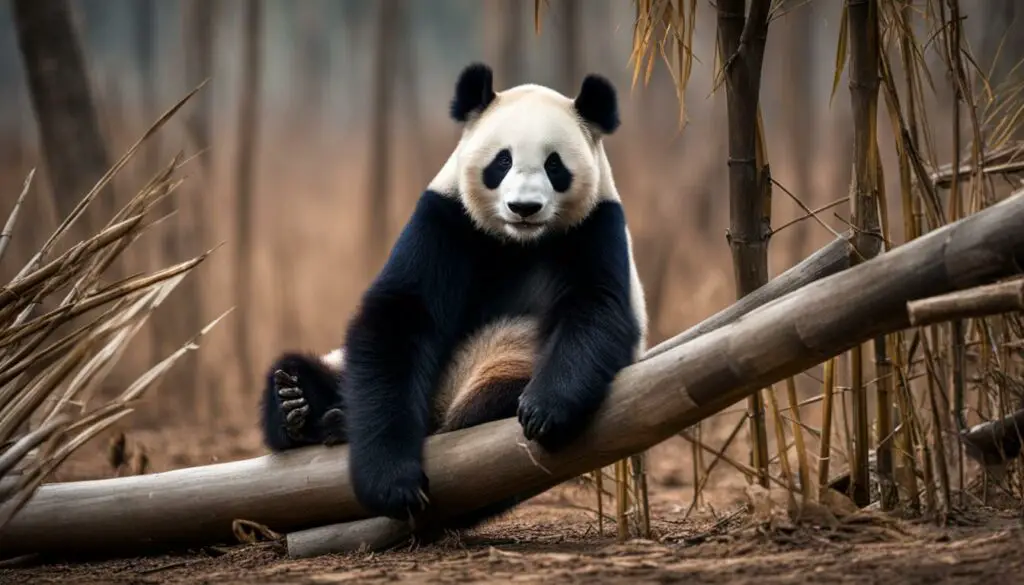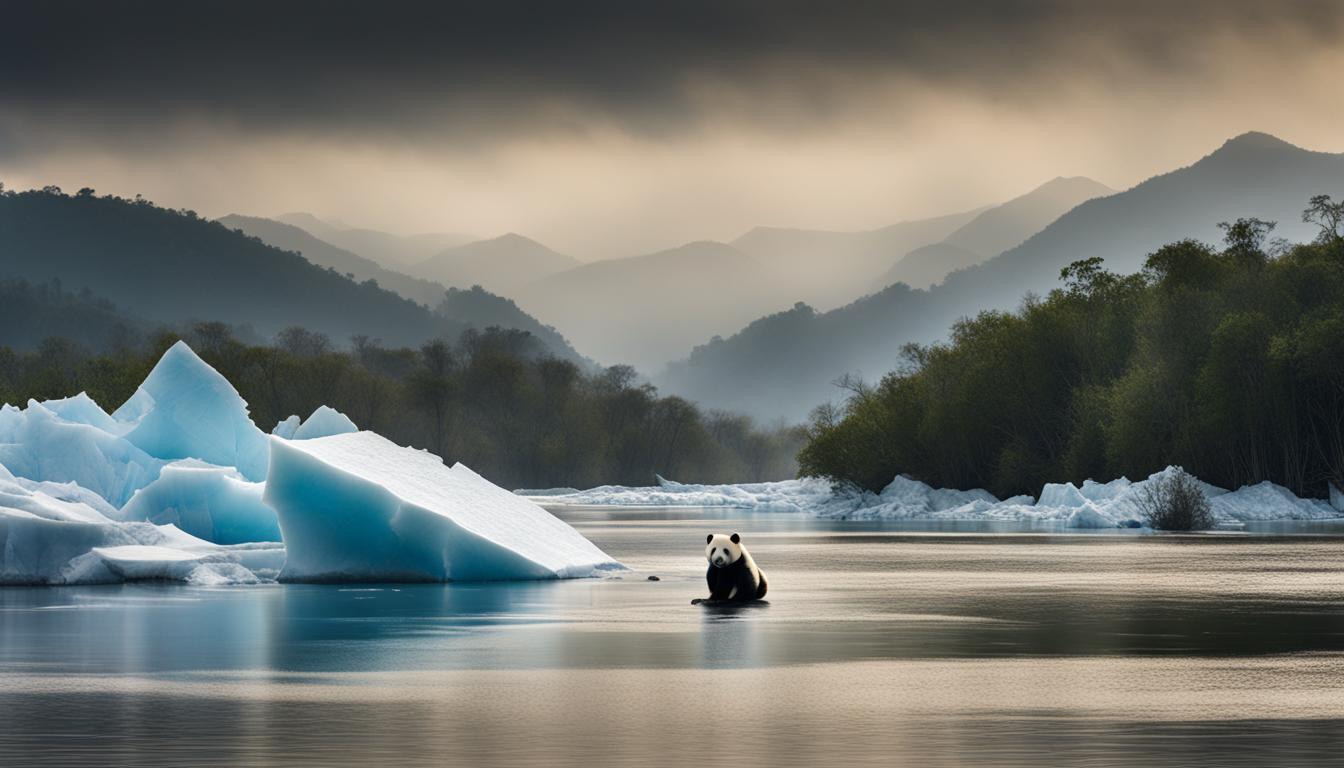Welcome to our article on the fascinating relationship between pandas and climate change. In this piece, we will explore the impacts of climate change on these beloved creatures and the efforts being made to protect them. As the world’s attention focuses on the urgent need for conservation, understanding the challenges faced by panda populations becomes ever more crucial.
Climate change poses a significant threat to giant pandas, causing habitat loss, reduced breeding viability, and fragmentation of their populations. These endangered animals face an uncertain future, highlighting the importance of conservation measures to preserve their existence.
Join us as we delve into the specific challenges faced by pandas due to climate change, the vulnerability of their populations, and the strategies being implemented to protect these iconic creatures. Stay tuned to learn how you can contribute to the conservation efforts and ensure the survival of pandas in a changing world.
The Impact of Climate Change on Panda Habitat
Climate change is having a devastating effect on the habitat of giant pandas, leading to significant challenges for their survival. As global warming intensifies, pandas are being forced to move higher and deeper into the mountains of China in search of their main food source, bamboo. This has resulted in fragmented populations and increased isolation for these iconic animals.
The impact of climate change on panda habitat is further compounded by the synchronistic mass flowering of bamboo, which occurs every 65 to 120 years. This natural phenomenon poses a major risk, as it can lead to mass deaths of bamboo, further exacerbating the loss of suitable habitat for pandas.
The study predicts that if climate change continues unchecked, panda populations will become even more vulnerable to extinction. The loss of suitable bamboo habitat, coupled with the fragmentation of populations, poses a significant threat to the long-term survival of these magnificent creatures.
Table: Impact of Climate Change on Panda Habitat
| Climate Change Effects | Consequences for Panda Habitat |
|---|---|
| Higher temperatures | Forces pandas to move higher into the mountains |
| Decreased bamboo availability | Leads to loss of suitable habitat and fragmented populations |
| Synchronistic mass flowering of bamboo | Results in mass deaths of bamboo and further habitat loss |
| Increased risk of extinction | Threatens the long-term survival of panda populations |
The preservation of panda populations and protection of their habitat are essential in the face of climate change. Efforts must be made to restore connectivity between fragmented populations and introduce new breeding stock to enhance genetic diversity and breeding viability. Additionally, conservation strategies should focus on planting bamboo in areas that will become suitable habitat in the future and creating natural bridges to help pandas escape bamboo famines.
The Vulnerability of Giant Panda Populations
The study’s models show that populations with fewer than 30 individuals have a one in five chance of going extinct in 100 years. Demographic accidents, such as the premature deaths of breeding-age females or imbalances in the number of male and female offspring, can speed up an isolated population’s decline. Inbreeding and loss of genetic diversity also reduce the fitness of panda populations. Efforts to conserve pandas in the face of climate change include creating corridors of protected land to connect isolated populations and introducing new breeding stock.
Conserving Genetic Diversity
Conserving genetic diversity is a crucial aspect of preserving giant panda populations. Inbreeding can lead to a decrease in fertility and an increase in susceptibility to diseases. To combat this, conservation programs aim to introduce new breeding stock to increase genetic diversity and enhance the resilience of the panda population. By carefully selecting individuals from different regions, scientists can maximize the genetic variability within the population.
Restoring Connectivity
Fragmentation of panda populations due to habitat loss and climate change poses a significant threat to their survival. To address this, conservation efforts focus on creating corridors of protected land that connect isolated populations. These corridors allow pandas to move freely between fragmented habitats, facilitating gene flow and promoting genetic diversity. By restoring connectivity, it increases the chances of successful breeding and enhances the long-term survival prospects of giant pandas.
| Effort | Description |
|---|---|
| Creating Corridors | Establishing protected land corridors to connect fragmented panda populations, promoting genetic diversity and facilitating movement between habitats. |
| Introducing New Breeding Stock | Selecting diverse individuals from different regions to introduce to isolated populations, increasing genetic diversity and enhancing resilience. |
| Conserving Bamboo Habitat | Preserving and restoring bamboo forests, the primary food source of pandas, to ensure their access to nutrition and reduce the threat of starvation. |
Efforts to conserve pandas in the face of climate change require a comprehensive approach that addresses both the ecological and genetic aspects of their vulnerability. By creating connectivity between fragmented populations and introducing new breeding stock, conservationists aim to increase the resilience and adaptability of giant pandas in the changing climate. Preserving their habitat and food sources, such as bamboo forests, is also crucial for their survival. With concerted efforts and continued research, it is possible to mitigate the impacts of climate change on giant panda populations and secure their future for generations to come.

The Threat to Giant Panda Food Sources
Climate change is having a severe impact on the availability of food sources for giant pandas. As their habitats continue to be affected by global warming, the bamboo forests that pandas rely on are dying off. Bamboo constitutes almost the entire diet of giant pandas, making them highly dependent on its availability. However, the study reveals that within the next 50 to 100 years, most of the current bamboo habitat will become unsuitable for pandas, leaving them with limited options for sustenance.
This loss of bamboo not only reduces the quantity of food available to pandas but also impacts their ability to adapt to a changing environment. As nutritious alternatives to bamboo are scarce, pandas are left lethargic and vulnerable. This lack of food diversity hampers their capacity to cope with the challenges posed by climate change. Even if bamboo does grow in other areas, it often occurs outside the boundaries of current panda reserves, making it difficult for pandas to access.
To illustrate the severity of the situation, consider the following table:
| Year | Bamboo Forest Area (in hectares) | Panda Population |
|---|---|---|
| 2000 | 500,000 | 1,000 |
| 2020 | 350,000 | 1,200 |
| 2050 | 200,000 | 800 |
| 2100 | 100,000 | 500 |
This table highlights the rapid decline of both bamboo forest area and panda population over time. As the available bamboo shrinks, so does the panda population, ultimately threatening their survival.
In conclusion, the loss of bamboo as the primary food source for giant pandas due to climate change poses a significant threat to their survival. Without adequate access to nutritious alternatives, pandas struggle to adapt to their changing environment. Urgent action is needed to address this critical issue and preserve the delicate balance of panda ecosystems.
Conservation Strategies for Pandas in a Changing Climate
Giant pandas are a vulnerable species that face numerous challenges, including the impacts of climate change on their habitats. To ensure the survival of these beloved animals, effective conservation strategies must be implemented.
One key strategy is to protect and preserve panda habitat. This can be achieved by creating and maintaining protected areas that provide suitable conditions for pandas to thrive. Planting bamboo in areas that will become suitable habitat in the future is also essential. By anticipating and addressing future changes in panda habitat, conservation efforts can help ensure that pandas have access to their primary food source and suitable living conditions.
Another crucial conservation strategy is to preserve panda populations. This can be accomplished by connecting fragmented populations through the creation of corridors of protected land. These corridors allow pandas to move freely between their habitats, increasing their chances of survival. Additionally, introducing new breeding stock from different panda populations can help enhance genetic diversity and strengthen the overall resilience of panda populations.
| Conservation Strategies for Pandas | Benefits |
|---|---|
| Create protected areas with suitable conditions | Preserves panda habitat and ensures they have access to food sources |
| Plant bamboo in future suitable habitat areas | Anticipates changes in panda habitat and provides a future food source |
| Create corridors of protected land | Connects fragmented populations and allows for movement between habitats |
| Introduce new breeding stock | Enhances genetic diversity and strengthens population resilience |
Furthermore, it is crucial to cut emissions and limit global warming to protect pandas in the long term. By reducing greenhouse gas emissions, we can slow down the rate of climate change and mitigate its negative impacts on panda habitats. This requires a collective effort from individuals, communities, and governments to transition towards more sustainable energy sources and reduce our carbon footprint.
Conservation strategies that focus on preserving panda habitat, protecting populations, and addressing climate change are essential for the long-term survival of giant pandas. By implementing these strategies, we can ensure that future generations get to marvel at the beauty and uniqueness of these incredible creatures.
Conclusion
Giant pandas are facing increasing risks due to climate change, habitat loss, and reduced breeding viability. These beloved animals are at risk of extinction if immediate action is not taken to protect them.
Efforts to conserve pandas in the face of climate change are crucial for their survival. Creating corridors of protected land to connect fragmented populations and introducing new breeding stock are essential strategies. Additionally, modifying conservation approaches to account for a changing climate, such as planting bamboo in future suitable habitats and creating natural bridges, can further safeguard pandas from the impacts of climate change.
It is imperative to act now to preserve and conserve pandas. By addressing the challenges posed by climate change, protecting their habitat, and ensuring their access to food sources, we can mitigate the risk of panda extinction. Together, we can secure a future where these remarkable creatures thrive in a changing world.
How Does Climate Change Impact the Tundra Animals’ Habitat and Survival?
The changing climate has significant impacts on animals in the tundra wildlife. Increased temperatures are causing permafrost to melt, leading to habitat loss for species like polar bears and caribou. Furthermore, changes in precipitation patterns and extreme weather events pose challenges for the survival of tundra animals.
FAQ
How are giant pandas affected by climate change in their habitats?
Giant pandas are facing increased risks due to climate change, including habitat loss, reduced breeding viability, and fragmented populations.
What is the impact of climate change on panda habitat?
Climate change is causing bamboo, the primary food source for giant pandas, to die off in their habitats. This leads to fragmented populations and a reduced ability for pandas to adapt to a changing environment.
What is the vulnerability of giant panda populations to climate change?
The fragmentation of panda populations and the potential loss of bamboo as a food source pose significant threats to their survival. Populations with fewer than 30 individuals have a high risk of extinction within 100 years.
What is the threat to giant panda food sources?
Climate change is causing bamboo to become unsuitable for pandas within 50 to 100 years. Lack of nutritious alternatives to bamboo leaves pandas lethargic and reduces their ability to adapt to a changing environment.
What are the conservation strategies for pandas in a changing climate?
Conservation strategies include restoring connectivity between panda populations, introducing new breeding stock, planting bamboo in future suitable habitats, and creating natural bridges to help pandas escape bamboo famines.
What are the efforts to conserve pandas in the face of climate change?
Efforts to conserve pandas in the face of climate change include creating corridors of protected land, moving threatened groups of pandas to ensure their access to food, and cutting emissions to limit global warming.











